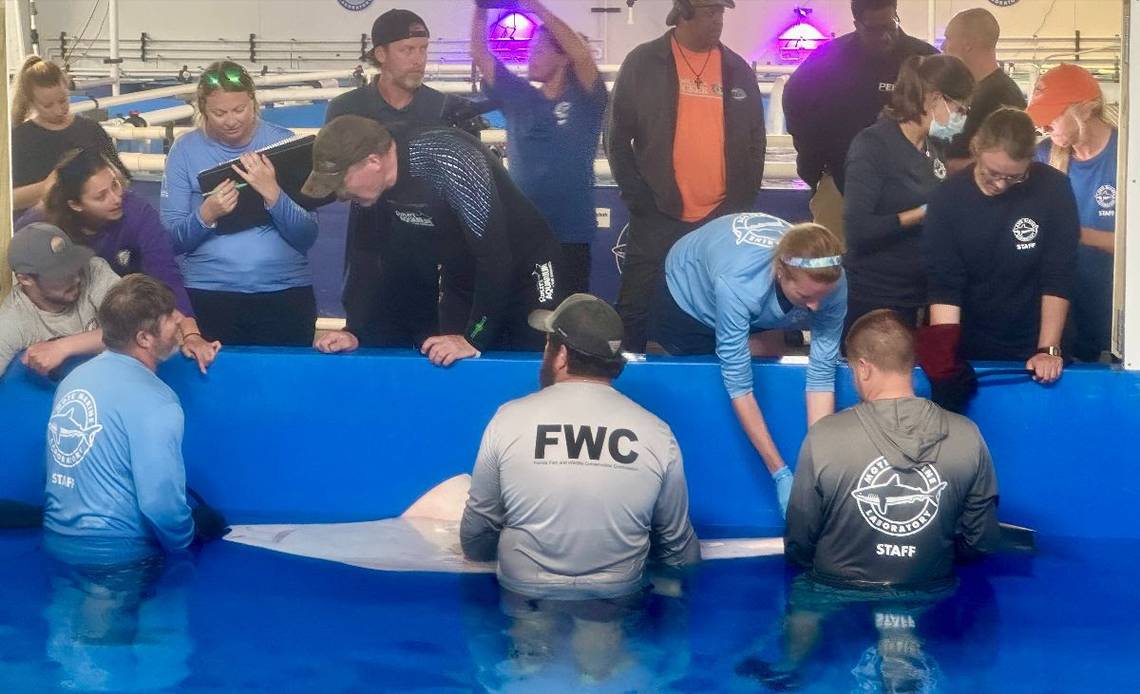A promising development in an ongoing fish kill in the Florida Keys took an unfortunate turn this week when a sick and endangered sawfish died after being rescued from the island chain’s waters and brought to Sarasota for his rehabilitation.
Scientists at Mote Marine Laboratory had to euthanize the shark-like ray on Thursday because its health continued to deteriorate, it was announced Friday.
“We have always been cautiously hopeful that we could use the best science available for the rehabilitation and release of sawfish,” Dr. Michael P. Crosby, president and CEO of Mote Marine Laboratory & Aquarium, said in a statement.
“Although heartbreaking, this result was not surprising. Mote’s several decades of active rescue and rehabilitation efforts have taught us that these efforts are not always successful in fully rehabilitating stranded animals in distress.”
the sawfish was rescued from the shallow waters off Cudjoe Key in the Lower Keys on April 5 after members of the public reported it was swimming in circles, which is a behavior sick sawfish have been exhibiting in the Keys since the beginning of the year.
As of Jan. 29, the Florida Fish and Wildlife Conservation Commission says 45 sawfish have been found dead in the Keys. That creates a dire situation for the species, as the Keys are one of the few places where they can still be found in the wild. Their habitat once stretched from Texas to North Carolina, but sawfish populations have declined considerably and they were placed on the Endangered Species List in 2003.
Alarmingly, the spinning behavior observed in smalltooth sawfish in the Keys has also been reported in several other species that scientists believe is related to a fish kill first reported in November.
Biologists from Mote, academia, the National Oceanic and Atmospheric Administration, FWC and nonprofit organizations like Bonefish and Tarpon Trust have been continually working to get to the bottom of what is causing the phenomenon, which is primarily limited to the Lower Keys. , from Big Pine Key to Key West.
The FWC has received more than 460 reports on its hotline dedicated to fish kills in the Keys.
So far, red tide toxins have been ruled out based on water samples taken in the impacted area.
And necropsy data taken from dead fish samples have so far revealed no transmissible pathogens and the fish tested negative for bacterial infections, according to the FWC.
According to the FWC, dissolved oxygen levels, salinity, acidity and temperature are also not suspected as causes of fish death or turning.
State scientists have also tested water for a variety of chemicals, “which were either undetected or below normal limits,” the FWC said on its fish kill site.
Scientists have speculated that the erratic spinning behavior may be related to a toxin called gambierdiscus, which causes a foodborne illness called ciguatera in people who eat infected fish. It is common in the Keys because it grows as a microalgae on the coral reef. Basically, smaller fish eat the algae and the toxin passes up the food chain to people who eat larger predatory fish.
In the meantime, the FWC will conduct a necropsy to try to determine what made the sawfish in Mote’s care sick.
“Samples will be collected and sent to various laboratories for further analysis,” Mote said in a statement. “Necropsies do not always determine the cause of death and it could take weeks or months to get a complete picture of the animal’s condition.”
To report a sick sawfish, call (844) 4-SAWFISH (844-472-9347) or email sawfish@myfwc.com.
Report abnormal fish behavior and fish kills to the Florida Fish and Wildlife Conservation Commission’s Fish Kill Hotline at (800) 636-0511 or MyFWC.com/ReportFishKill.


